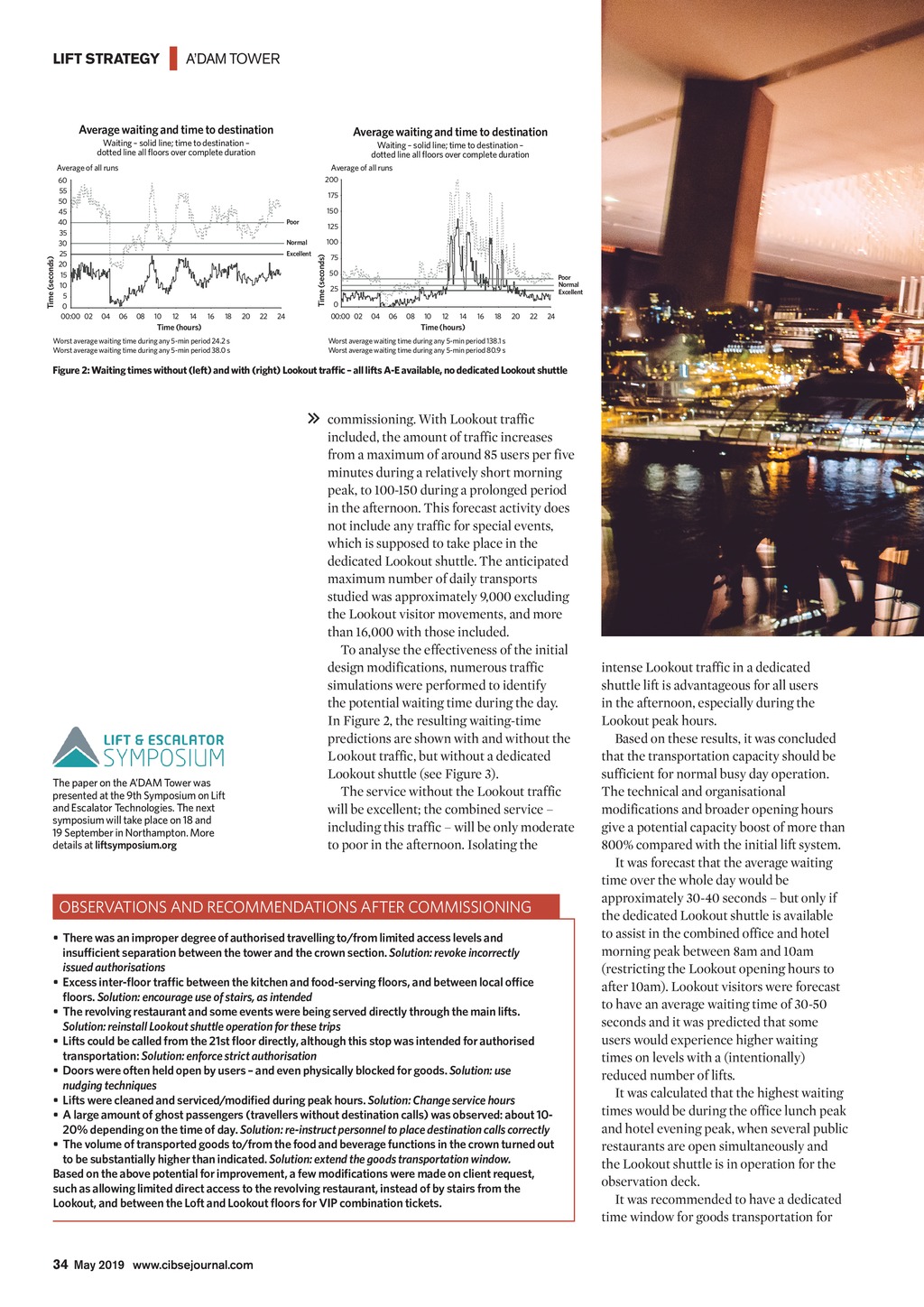




LIFT STRATEGY | ADAM TOWER Average waiting and time to destination Average waiting and time to destination Waiting solid line; time to destination dotted line all oors over complete duration Waiting solid line; time to destination dotted line all oors over complete duration 60 55 50 45 40 35 30 25 20 15 10 5 0 00:00 02 Average of all runs 200 175 150 Poor 125 100 Normal Excellent 04 06 08 10 12 14 16 18 20 Time (hours) Worst average waiting time during any 5-min period 24.2 s Worst average waiting time during any 5-min period 38.0 s 22 24 Time (seconds) Time (seconds) Average of all runs 75 50 Poor Normal Excellent 25 0 00:00 02 04 06 08 10 12 14 16 18 20 22 24 Time (hours) Worst average waiting time during any 5-min period 138.1 s Worst average waiting time during any 5-min period 80.9 s Figure 2: Waiting times without (left) and with (right) Lookout trafc all lifts A-E available, no dedicated Lookout shuttle The paper on the ADAM Tower was presented at the 9th Symposium on Lift and Escalator Technologies. The next symposium will take place on 18 and 19 September in Northampton. More details at liftsymposium.org commissioning. With Lookout traffic included, the amount of traffic increases from a maximum of around 85 users per five minutes during a relatively short morning peak, to 100-150 during a prolonged period in the afternoon. This forecast activity does not include any traffic for special events, which is supposed to take place in the dedicated Lookout shuttle. The anticipated maximum number of daily transports studied was approximately 9,000 excluding the Lookout visitor movements, and more than 16,000 with those included. To analyse the effectiveness of the initial design modifications, numerous traffic simulations were performed to identify the potential waiting time during the day. In Figure 2, the resulting waiting-time predictions are shown with and without the Lookout traffic, but without a dedicated Lookout shuttle (see Figure 3). The service without the Lookout traffic will be excellent; the combined service including this traffic will be only moderate to poor in the afternoon. Isolating the OBSERVATIONS AND RECOMMENDATIONS AFTER COMMISSIONING There was an improper degree of authorised travelling to/from limited access levels and insufcient separation between the tower and the crown section. Solution: revoke incorrectly issued authorisations Excess inter-oor trafc between the kitchen and food-serving oors, and between local ofce oors. Solution: encourage use of stairs, as intended The revolving restaurant and some events were being served directly through the main lifts. Solution: reinstall Lookout shuttle operation for these trips Lifts could be called from the 21st oor directly, although this stop was intended for authorised transportation: Solution: enforce strict authorisation Doors were often held open by users and even physically blocked for goods. Solution: use nudging techniques Lifts were cleaned and serviced/modied during peak hours. Solution: Change service hours A large amount of ghost passengers (travellers without destination calls) was observed: about 1020% depending on the time of day. Solution: re-instruct personnel to place destination calls correctly The volume of transported goods to/from the food and beverage functions in the crown turned out to be substantially higher than indicated. Solution: extend the goods transportation window. Based on the above potential for improvement, a few modications were made on client request, such as allowing limited direct access to the revolving restaurant, instead of by stairs from the Lookout, and between the Loft and Lookout oors for VIP combination tickets. intense Lookout traffic in a dedicated shuttle lift is advantageous for all users in the afternoon, especially during the Lookout peak hours. Based on these results, it was concluded that the transportation capacity should be sufficient for normal busy day operation. The technical and organisational modifications and broader opening hours give a potential capacity boost of more than 800% compared with the initial lift system. It was forecast that the average waiting time over the whole day would be approximately 30-40 seconds but only if the dedicated Lookout shuttle is available to assist in the combined office and hotel morning peak between 8am and 10am (restricting the Lookout opening hours to after 10am). Lookout visitors were forecast to have an average waiting time of 30-50 seconds and it was predicted that some users would experience higher waiting times on levels with a (intentionally) reduced number of lifts. It was calculated that the highest waiting times would be during the office lunch peak and hotel evening peak, when several public restaurants are open simultaneously and the Lookout shuttle is in operation for the observation deck. It was recommended to have a dedicated time window for goods transportation for 34 May 2019 www.cibsejournal.com CIBSE May19 pp32-35 Adam Tower lift.indd 34 26/04/2019 18:33